Running the same webinar every week drains your team's energy and limits your reach. Your prospects span multiple time zones, and you can't be available for all of them. Automated webinars solve this problem by delivering your presentation consistently without requiring your presence.
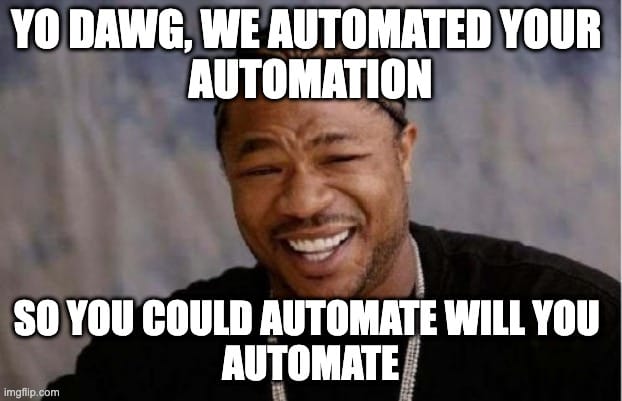
As B2B marketing continues its digital transformation, with 64% of marketers now hosting webinars as one of their top-performing content formats, the shift toward webinar automation has become essential for businesses. The virtual events industry is projected to reach $103 billion by 2032, growing at 14% annually.
This guide walks you through everything you need to learn about creating automated webinar funnels that generate leads around the clock. Whether you're new to automated webinar platforms or looking to improve your existing setup, you'll find practical steps to follow.
What is an automated webinar and how does it work?
Many people confuse automated webinars with simple recorded videos. The difference matters. A recorded video just plays when someone clicks it. An automated webinar creates an event experience with scheduled times, interactive features, and built-in engagement tools.
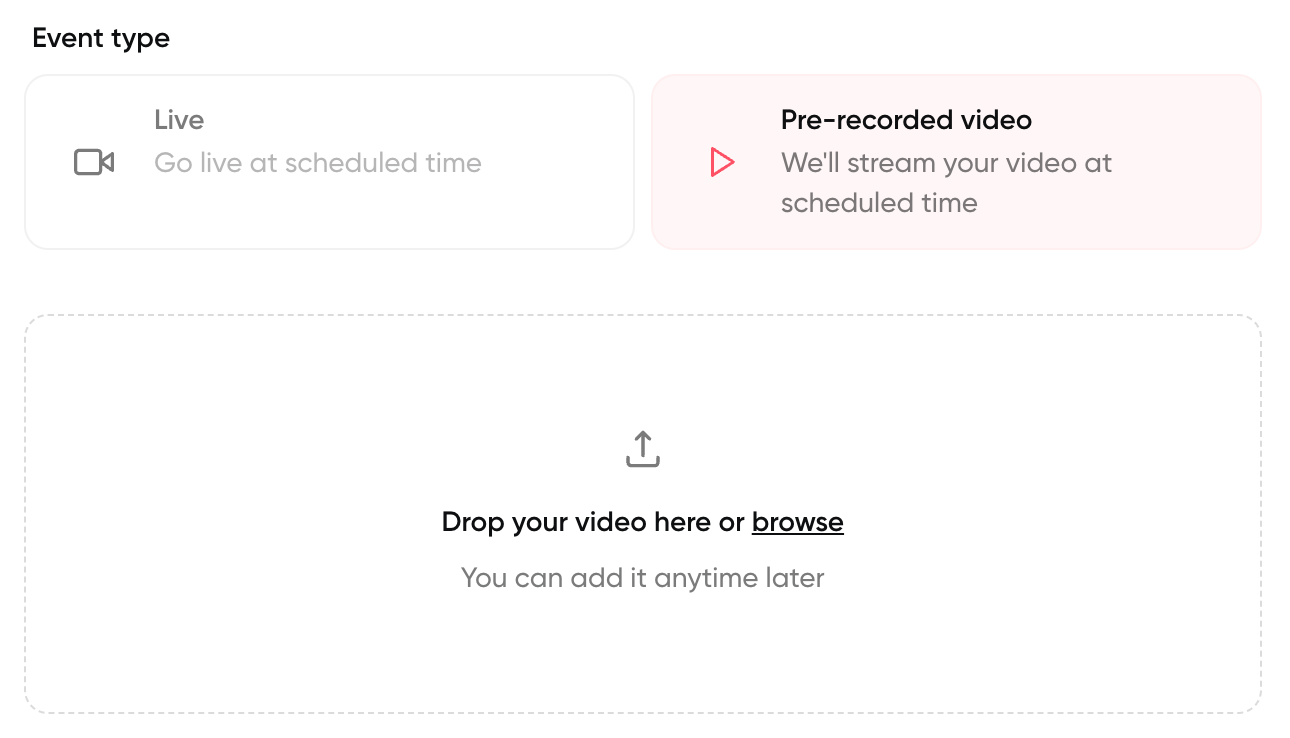
Automated webinar software manages your entire webinar session workflow. It schedules sessions across different time zones automatically. It sends email reminders and confirmation sequences. It handles registration forms with custom registration fields and collects attendee data through your webinar dashboard.
The technology works by syncing your pre-recorded presentation with interactive elements. When someone registers, they choose a start time. The system automatically adjusts for their time zone and creates a session just for them. During the webinar, polls appear at the right moments. Chat messages stay active. Call-to-action buttons display when you planned them to create an engaging experience for webinar attendees.
Automated webinars vs live webinars: key differences
Live events give you spontaneity but don't scale well. Automated webinars deliver consistency across every webinar session. Your best presentation, with your best energy and clearest explanations, runs whether it's Tuesday afternoon or Saturday midnight. You can host live and automated webinars simultaneously—offering 20 automated sessions per day across every time zone without burning out.
Most successful businesses use both. They run automated webinars for 90% of their volume and save live events for high-value prospects.
Automated webinars vs on-demand videos
On-demand webinars let people watch whenever they want. They skip around, speed up playback, and leave when they lose interest. There's no commitment and no urgency.
Automated webinars create a live event experience. People register days in advance. They block time on their calendar. They show up at a specific start time and experience your content from start to finish. This format generates commitment that on-demand webinar viewing never achieves.
The webinar format also enables scarcity and urgency through automated offers. You can offer bonuses that expire at session end. You capture lead data before delivering value. Registration forms collect emails, job titles, and company information upfront through custom registration fields.
Should you create an automated webinar? Use cases and ROI analysis
When automated webinars are the right choice for your business
Automated webinars work when you have a repeatable message that needs to reach many people. If you're explaining the same concepts repeatedly and answering the same objections, automation makes sense.
The best candidates share common traits. They sell complex products that require education through tutorials and demonstrations. Their sales cycles span weeks or months, not hours. Their target audiences live in different time zones and work different schedules.
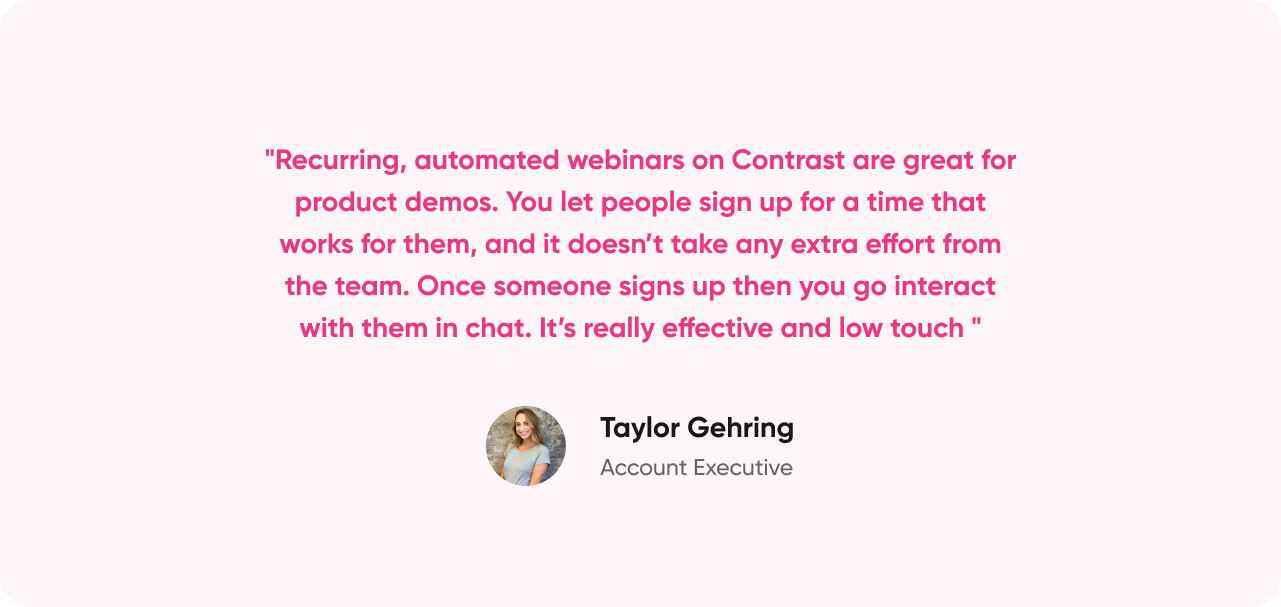
B2B SaaS businesses with monthly pricing over $500 see strong results. Online course creators use automated webinars as their primary sales tool for promoting their programs. Consultants and agencies use them to educate prospects before sales calls. E-commerce brands with premium products use webinars to demonstrate value and generate income.
Expected ROI and performance benchmarks
Well-executed automated webinars see 20-40% of attendees entering the sales pipeline as qualified leads, with eventual conversion rates of 2-5% for mid-ticket offers between $500 and $2,000. High-ticket offers above $3,000 typically convert 1-5% through automated offers and sales sequences.
Attendance rates for automated webinars typically hover around 25-40%, compared to 40-50% for live webinars. But you're running more sessions on a recurring schedule. Twenty automated sessions per week versus two live events means more absolute attendees despite lower percentages. Replay views can add 15-36% additional viewership beyond live attendance, extending your webinar experience.

Cost per registration averages $72 across industries, typically ranging from $45 to $98. Time savings matter too. Live events three times weekly consume 20+ hours monthly. Automated webinars take 10-20 hours to create once, then run forever on autopilot.
How much does it cost to create an automated webinar?
Total investment ranges from under $500 for basic DIY setups to $5,000-$15,000 for professional produced content.
Platform fees run $50-$500+ monthly depending on webinar features and attendee limits. Recording equipment costs $400-$800 for respectable quality. You need a USB microphone ($100-$200), webcam ($80-$150), and ring light ($50-$150). Audio quality matters significantly more than video quality.
Editing software ranges from free to $50 monthly. Outsourcing editing costs $50-$150 per hour. Promotion costs vary most through email campaigns and paid ads. Paid ads run $45-$98+ per registration depending on your industry and marketing tools used.
Total timeline spans 18-42 hours from start to launch. Planning and scripting take 8-16 hours. Recording your automated video consumes 2-6 hours. Editing requires 4-12 hours. Platform setup and testing need 4-8 hours.
12 best automated webinar platforms: what to look for
Platform choice significantly impacts your webinar experience. Each tool offers different strengths and limitations. When evaluating the 12 best automated webinar platforms, focus on features that matter most for your business.
Essential features to look for
Must-have webinar features include automated scheduling with time zone management. You need a robust registration system with landing page templates and custom registration fields. Live chat capabilities keep attendees engaged. Polls and surveys add interaction. Clickable CTAs drive conversions through automated offers.
Analytics and engagement tracking show you what works through detailed analytics and an analytics dashboard. CRM and email marketing integrations connect your webinar to your broader sales and marketing stack. Mobile-responsive design ensures attendees can join from any device—critical since over 22% of registrations come from mobile.
Some platforms excel at simulating live experiences with viewer counts and typing indicators for your webinar attendees. Others focus on transparent automation. Some offer individual-level behavior tracking with engagement heatmaps in their dashboard.
Look for platforms with strong customization options for branding. A powerful interface makes setup easier. The right tool should offer custom landing page templates and flexible plan options. Check if the platform provides handouts sharing, detailed analytics, and community features.
Top platforms include WebinarJam, EasyWebinar, and Livestorm. Each has strengths and weaknesses. Research based on your specific requirements using a best webinar software comparison.
Test strategically during a free trial. Most platforms offer a 14-day free trial or 30-day free trial. Days 1-4, create a webinar and evaluate interface intuitiveness. Days 5-8, build registration pages with landing page templates and email campaigns to assess flexibility. Days 9-12, test the webinar experience on desktop and mobile devices. Days 13-14, verify analytics exports and integrations work properly.
Match webinar features to your use case. SaaS demos need strong screen recording capabilities. Lead generation demands seamless CRM integration. Solo entrepreneurs need different features than enterprise teams.

Create automated webinars with Contrast
Start for free up to 30 registrants. No credit card needed.
Start for freeHow to create an automated webinar: step-by-step process
Step 1 - Planning your automated webinar strategy
Define specific, measurable goals. Instead of "generate leads," aim for "generate 50 qualified leads monthly with 3% conversion to booked calls." Your goal determines content focus, CTA placement, and sales and marketing follow-up sequences.
Understanding your audience matters more than technical execution. Interview customers and analyze support tickets. What objections do prospects raise consistently? Your webinar must address these details directly.
Choose evergreen topics that stay relevant for years. Avoid time-sensitive content that expires quickly. Focus on evergreen webinars and tutorials that remain valuable. Better topics include "How to Build High-Converting Sales Funnels" or "Scaling Service Businesses Without Burnout."
Script your webinar for precision when creating an automated webinar. Automated presentations don't allow real-time adjustments. Script your transitions, stories, sales offers, and objection handling.
Step 2 - Recording your automated webinar presentation
Audio quality matters significantly more than video quality. People tolerate average video but won't tolerate poor audio in their personal experience. Test your audio levels before recording the full presentation.
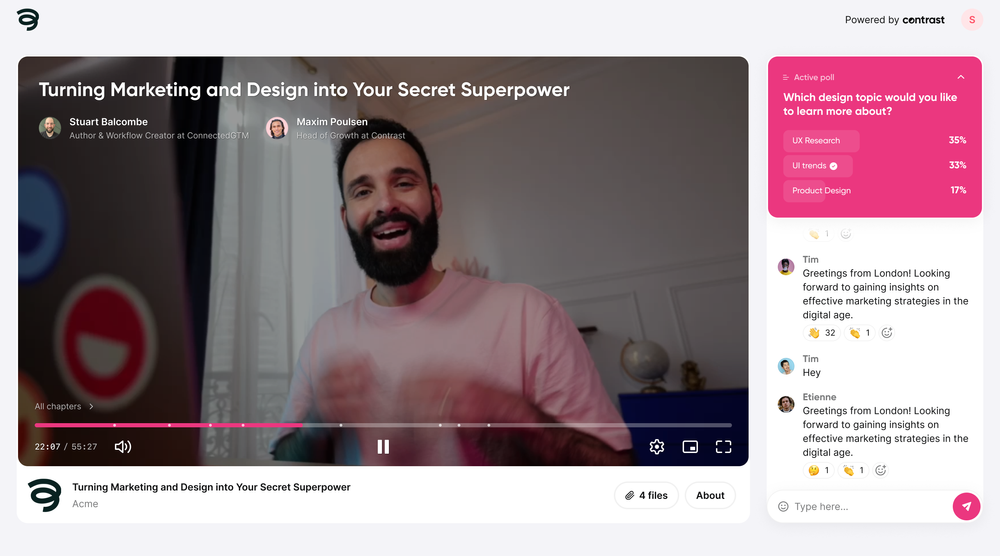
Stand while presenting to project more energy. Be more animated than you normally would. Smile frequently, gesture naturally, and vary your vocal tone to host an engaging presentation.
Recording software options range from free to paid. Zoom and OBS Studio work without cost. Break up visual monotony. Mix talking-head segments with slides, screen recordings, and graphics. Add handouts and supporting materials throughout your automated video.
Step 3 - Editing and optimizing your recording
Cut dead air, remove mistakes, and tighten pacing. If you paused 5 seconds while thinking, cut it to 1 second. Remove redundancy and tangents to improve the webinar experience.
Remove time-sensitive references to keep content evergreen. Replace "earlier this year" with "recently." Include captions for accessibility and better user engagement. Many viewers watch videos with sound off, especially on mobile devices.
Optimal webinar length runs 45-60 minutes. Structure it as 5 minutes intro, 30-40 minutes content, 10-15 minutes pitch with sales offers, 5 minutes recap.
Step 4 - Setting up automated webinars in your platform
Most platforms accept MP4 files with H.264 encoding at 1080p resolution. Start uploads well before your launch date to your webinar dashboard.
Decide how many sessions you'll offer daily on your recurring schedule. A common approach offers 2-3 sessions daily covering morning, afternoon, and evening across major time zones.
Just-in-time webinars start minutes after registration, capitalizing on immediate interest. Fixed-schedule webinars require advance registration, building anticipation. Both options work for different business models.
Setting up the webinar registration process
Creating high-converting webinar registration pages
Keep registration pages simple and focused. Remove navigation menus and sidebar elements. Create one clear path forward: fill out the form and register. Use professional landing page templates with strong branding.
Craft headlines using a proven formula for your webinar landing page. Combine a specific outcome with a time frame and remove a common obstacle. "Build a $10K/Month Sales Funnel in 90 Days Without Paid Ads" beats "Marketing Webinar" every time.
Include 3-5 bullet points highlighting concrete takeaways. Add social proof through testimonials, attendee counts, and company logos. Provide clear details about what attendees will learn.
Optimizing your registration form
Essential fields include only name and email. Every additional field increases friction and reduces conversions. Check if you actually need custom registration fields like company name or job title. Only ask for information you'll actually use for segmentation through your sales and marketing system.

Automate the sign up process
Send an immediate confirmation email after registration. Automate the sign up process completely through your webinar dashboard. People who add webinars to their calendar show significantly higher attendance rates. Make calendar integration effortless.
Standard reminder sequences include three touchpoints through email reminders: 24 hours before, 1 hour before, and 15 minutes before. Each reminder should re-sell value, not just state logistics. Send timely reminders that maintain excitement.
Tag registrants in your CRM and trigger nurture sequences. No-shows enter different email campaigns than attendees. Your automation should branch automatically based on actions taken for future webinars.
How to enhance audience engagement in automated webinars
Keeping people engaged during pre-recorded presentations requires deliberate planning. You need to engineer interaction into your timeline to create an engaging experience.
Interactive elements that create engagement
Live chat is essential for automated webinars. Use human moderators for high-value sessions or peak times to manage chat messages. Deploy pre-programmed responses during off-hours to maintain an engaging atmosphere.
Place polls strategically at three points: early to engage immediately through a poll, mid-presentation to re-engage attention, and near the end to gauge interest in your automated offer. Simple polls with 3-4 options work best.
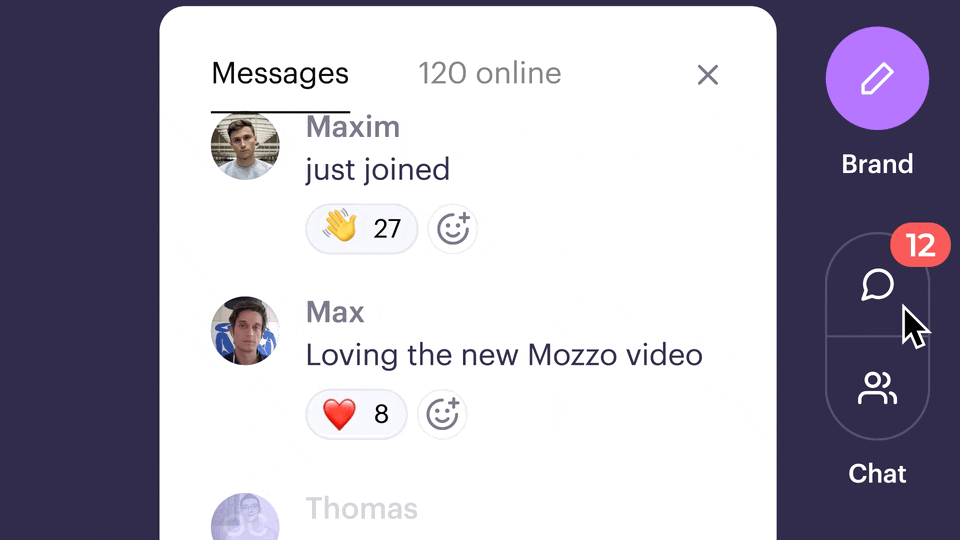
Timed CTAs drive conversions through automated offers. Display buttons linking to your sales page after you've delivered value and overcome objections. Timing matters as much as the offer itself. Create space in your presentation for clear calls-to-action.
Preventing drop-offs
Change something every 3-5 minutes to maintain the webinar experience. Switch from talking head to slides. Move from slides to screen share. Visual and content variety prevents attention drift.
Introduce interaction points every 8-10 minutes. "Drop your biggest takeaway in chat" creates engagement without complexity. Encourage chat messages and community participation.
Your analytics dashboard shows exactly where people leave. If 30% drop off at minute 22, investigate minute 22. Common triggers include overly long sections, confusing explanations, or promoting sales offers before establishing value. Review read your detailed analytics regularly.
How to generate leads with automated webinars
Building an effective webinar marketing funnel
Drive registrations through multiple channels using various marketing tools. Paid ads on Facebook, LinkedIn, and Google reach cold audiences. Organic content through blog posts attracts qualified visitors. Email lists provide warm traffic. Social media extends your reach.
Track behavior during your webinar session. Someone watching 95% and clicking every CTA shows higher qualification than someone watching 10% and leaving early. Use these behaviors for lead scoring in your sales and marketing system.
Send an immediate post-webinar email thanking attendees. Provide replay access and remind them of your automated offer with a clear CTA. Include a link to recorded content and relevant handouts.
Integrating into your sales strategy
Position webinars by funnel stage for different user journeys. Top-of-funnel webinars cover broad topics without hard pitches through educational tutorials. Middle-of-funnel content addresses specific pain points. Bottom-of-funnel presentations showcase exactly how your solution works with direct sales offers.
Your automated offer needs clarity, value, and urgency. Layer urgency through time-limited bonuses or deadline-based pricing when truthful for your business. Design custom offers that match your plan.
Tracking performance with webinar analytics
Essential metrics to monitor
Registration rate shows landing page effectiveness through your webinar landing page. Calculate it by dividing registrations by landing page visitors. Industry average runs 30-40% for warm traffic. Check your analytics dashboard weekly.
Attendance rate reveals reminder sequence quality and email reminders effectiveness. Automated webinars typically achieve 25-40% attendance. Below 25% indicates weak email campaigns or topics that fail to resonate.
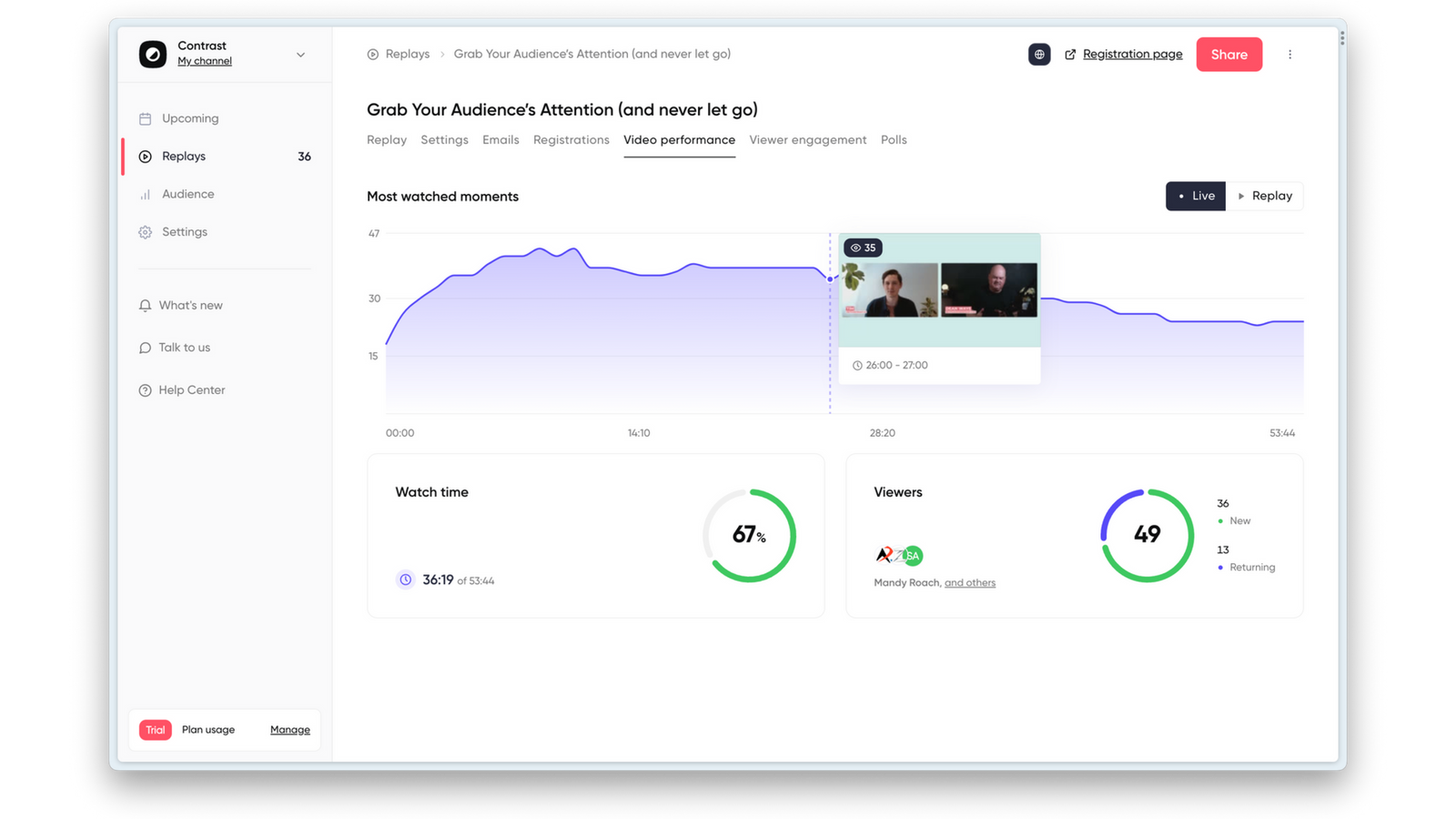
Engagement metrics show content quality through detailed analytics. Track average watch time, poll participation rates, chat messages activity levels, and CTA click-through rates in your dashboard.
Conversion rates matter most for measuring automated offer success. Track conversions at multiple time horizons: within 24 hours, within 7 days, and within 30-90 days. Monitor how webinar attendees respond to sales offers.
Using analytics to optimize
Your analytics dashboard should show exactly where people leave the webinar session. If 30% drop off at minute 22, investigate thoroughly through detailed analytics. Common problems include overly long sections, confusing explanations, or premature promoting before establishing value.
Create behavioral segments for targeted follow-up in your sales and marketing workflow. People who watched over 75% deserve different treatment than people who watched 20%. Review read your data regularly.
Test everything systematically using your marketing tools. Registration headlines, form fields with custom registration fields, and page copy all impact conversions. Even 5% improvements compound dramatically.
Common mistakes when creating an automated webinar
Content mistakes
Making webinars too sales-heavy turns people off. Aim for 70% value and 30% pitch. Deliver genuine teaching through tutorials before asking for the sale with sales offers.
Choosing non-evergreen topics wastes your investment. Focus on frameworks that remain valuable for evergreen webinars on a recurring schedule.
Ignoring engagement needs causes high drop-offs. Build in polls, questions, and stories. Vary your visuals throughout the entire post to maintain an engaging experience.

Technical mistakes
Poor audio quality is unforgivable for any professional presentation. People tolerate average video but won't tolerate unclear audio. Invest in a decent microphone for your automated video.
Missing mobile optimization loses 40%+ of your audience. If your webinar landing page or webinar experience breaks on smartphones, you're excluding nearly half your potential webinar attendees.
Marketing mistakes
Weak registration page copy reduces conversions dramatically on your webinar landing page. Be specific about outcomes and what attendees will learn. Inadequate email reminder sequences hurt attendance.
Not segmenting attendees for follow-up wastes opportunities in your sales and marketing process. Someone watching 95% deserves different email campaigns than someone watching 20%.
Getting started: your automated webinar launch checklist
Week 1-2: Planning and content creation
Define goals and success metrics clearly in your plan. Identify target audience and their pain points through research of your community. Choose an evergreen topic for future webinars. Write your script and design slides with custom branding.
Week 3: Production
Set up and test your recording equipment thoroughly. Record your webinar presentation for your automated video in one or two takes. Edit for quality by removing dead air and adding captions. Prepare any handouts or supplementary materials.
Week 4: Platform setup and launch
Upload your webinar to the platform dashboard. Configure scheduling and time zones correctly for your recurring schedule. Build your registration landing page using landing page templates. Set up email automation sequences including confirmation and email reminders with timely reminders. Test everything on multiple devices to ensure a smooth webinar experience.
Sign up for a free trial of your chosen platform if you haven't already. Most tools offer a 14-day free trial to test features. Soft launch to a small test audience first. Check feedback carefully and fix issues quickly. Begin your full promotional campaign through email campaigns and marketing tools.
First 30 days: Optimization
Review attendance and engagement metrics weekly in your analytics dashboard. Monitor chat messages for common questions. Analyze drop-off points through detailed analytics and investigate causes. Test variations on registration pages and email campaigns copy.
Read your analytics data carefully to understand user behavior. Track how webinar attendees engage with automated offers and respond to sales offers. Optimize your approach for future webinars on your recurring schedule.
Conclusion
Automated webinars require effort upfront but pay dividends continuously on autopilot. Success comes from persistence, attention to detail, and willingness to iterate based on data from your analytics dashboard.
Start with one webinar. Learn from the process. Launch it properly through your webinar dashboard. Watch your metrics closely in your analytics. Within six months, you could have a webinar funnel generating leads and income around the clock while you focus on other priorities in your business.
That's what automation delivers: freedom to work on strategy while your system handles execution. As marketing automation continues to evolve with AI integration, with 98% of marketers planning to integrate AI, the future promises even greater personalization and conversion optimization—making now the perfect time to build your automated webinar foundation with the right tool and plan for your professional growth.

